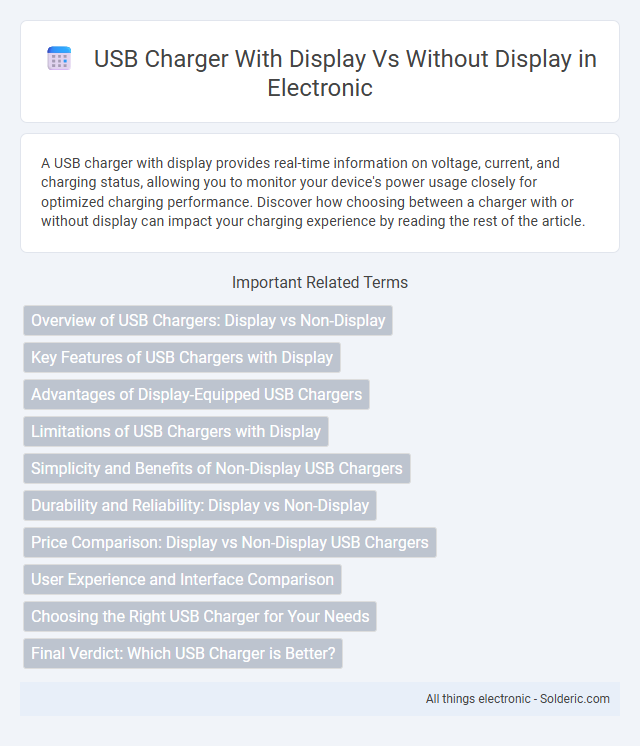A USB charger with display provides real-time information on voltage, current, and charging status, allowing you to monitor your device's power usage closely for optimized charging performance. Discover how choosing between a charger with or without display can impact your charging experience by reading the rest of the article.
Comparison Table
| Feature | USB Charger with Display | USB Charger without Display |
|---|---|---|
| Voltage & Current Monitoring | Yes, real-time data shown | No, no display of values |
| Charging Status | Visible on display | Only indicated by LED or none |
| Safety Features | Usually enhanced with live feedback | Basic protections, no feedback |
| Price | Higher, due to added screen tech | Lower, simpler design |
| Use Case | Ideal for monitoring and diagnostics | Suitable for basic, everyday charging |
| Power Efficiency | Comparable, slight additional consumption | Optimized for minimal energy use |
| Portability | Bulkier due to display module | Compact and lightweight |
Overview of USB Chargers: Display vs Non-Display
USB chargers with display provide real-time information on voltage, current, and charging status, allowing you to monitor and optimize device charging effectively. Non-display USB chargers focus on simplicity and cost-effectiveness, delivering power without detailed feedback. Choosing between them depends on your need for charging transparency versus straightforward plug-and-play functionality.
Key Features of USB Chargers with Display
USB chargers with display feature real-time monitoring of charging voltage and current, providing precise information for safer and more efficient device charging. These displays often include digital screens showing power output, enabling users to track energy consumption and detect charging anomalies promptly. Unlike chargers without display, they offer enhanced control and transparency, reducing risks of overcharging and extending battery lifespan.
Advantages of Display-Equipped USB Chargers
USB chargers with display provide real-time information on voltage, current, and charging status, allowing you to monitor device safety and optimize charging efficiency. These displays help prevent overcharging and overheating by offering precise control over power delivery, enhancing device longevity. Compared to chargers without displays, they offer greater transparency and control, making them ideal for users who prioritize device protection and efficient energy use.
Limitations of USB Chargers with Display
USB chargers with display offer real-time monitoring of voltage and current, but their limitations include higher cost, increased size, and potential durability issues due to added electronic components. They may also consume slightly more power and can provide distracting or unnecessary information for users who prefer simple plug-and-charge solutions. Choosing your charger depends on whether you value detailed charging data or prioritize compactness and affordability.
Simplicity and Benefits of Non-Display USB Chargers
Non-display USB chargers offer unmatched simplicity by eliminating screens and controls, making them easy to use and universally compatible without any setup. These chargers focus on straightforward charging with efficient power delivery, reducing potential points of failure and minimizing distractions. Without displays, they are often more compact, durable, and cost-effective, appealing to users who prioritize reliability and practicality over real-time monitoring.
Durability and Reliability: Display vs Non-Display
USB chargers with displays often feature advanced monitoring systems that enhance durability by preventing overcharging and overheating, thereby increasing reliability over time. Non-display chargers may lack real-time status indicators, which can lead to unnoticed faults and potentially shorten device lifespan due to unregulated power delivery. Investing in a charger with a display provides users with visual feedback that supports safer charging conditions and more consistent performance.
Price Comparison: Display vs Non-Display USB Chargers
USB chargers with display typically cost 20-30% more than non-display models due to the added screen technology that shows real-time voltage and current information. Non-display USB chargers offer a budget-friendly option, averaging between $10 to $15, while display chargers range from $15 to $25 or higher depending on brand and features. Choosing a display USB charger gives you precise monitoring of your device's charging status, which can justify the extra investment if you value detailed information.
User Experience and Interface Comparison
A USB charger with display enhances user experience by providing real-time information such as voltage, current, and charging status, allowing you to monitor device health and optimize charging efficiency. In contrast, a USB charger without display offers a straightforward, no-frills charging solution but lacks the interface feedback that helps prevent overcharging or device damage. The added interface of chargers with displays can improve usability, making them ideal for tech-savvy users who prioritize detailed control and monitoring during charging sessions.
Choosing the Right USB Charger for Your Needs
A USB charger with display offers real-time information on voltage, current, and charging status, allowing you to monitor and optimize your device's charging process effectively. Chargers without display provide basic charging functionality but lack detailed feedback, making it harder to detect issues such as slow charging or device incompatibility. Choosing the right USB charger depends on whether you prioritize advanced monitoring features or simple, reliable charging for everyday use.
Final Verdict: Which USB Charger is Better?
USB chargers with display provide real-time information on voltage, current, and charging status, enhancing user control and safety by preventing overcharging and overheating. Chargers without display offer simplicity and lower cost but lack the capability to monitor charging parameters, potentially risking device longevity. For users prioritizing device protection and charging efficiency, USB chargers with display present a superior option compared to those without display.
USB charger with display vs without display Infographic

 solderic.com
solderic.com